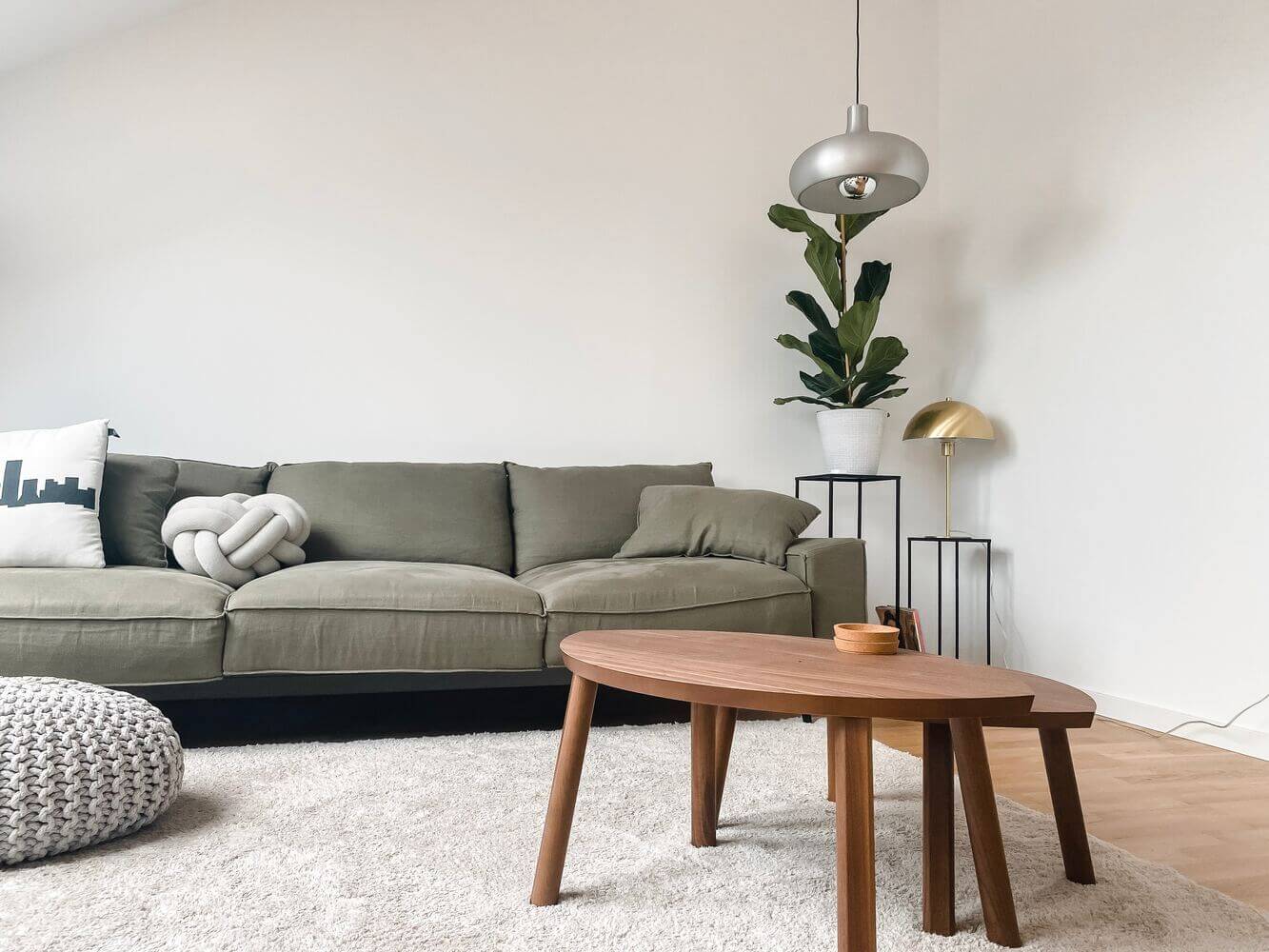Have you ever wondered if there is a way to make your old sofa look like new again? The good news is that there actually is a solution - reupholstering your sofa. In this article, you'll find out why reupholstering can be a great option, how to choose the right material for the upholstery, get a step-by-step guide to reupholstering and learn how to avoid common mistakes. We'll also give you tips on how to care for and maintain your reupholstered couch so you can enjoy it for years to come.
Why should you reupholster your sofa?
There are many reasons why it can make sense to reupholster your sofa. One of the main benefits is the cost savings compared to buying a new sofa. Imagine how much money you could save if you could restore your old sofa to the same condition as a new piece of furniture.
Another benefit is the ability to customize the look and comfort of your sofa. By changing the upholstery material and the cover you can add a personal touch to your living space and ensure that your sofa meets your individual needs.
For example, you can choose a luxurious velvet upholstery to add a touch of elegance to your living room. Or you can opt for a hard-wearing and easy-to-clean upholstery material if you want children or pets you have. The possibilities are endless!
In addition to customizing the look, you can also improve the comfort of your sofa. If you find that your current sofa no longer offers the desired seating comfort, you can adjust the upholstery by reupholstering it. You can choose softer or firmer upholstery, depending on your preferences.
Another reason to reupholster your sofa is sustainability. By reusing and upgrading your old sofa, you are helping to reduce waste and help the environment. Choosing to reupholster instead of buying a new sofa is therefore not only economically sensible, but also ecologically responsible.
And don't forget, reupholstering your sofa can also be an exciting DIY project! If you like craftsmanship, you can take on the challenge and reupholster your sofa yourself. There are many online tutorials and instructions that can help you with this. It's a great way to use your creative skills and create a unique piece of furniture.
There are also some suppliers where you can replacement covers or individual elements for your sofa. This has the advantage that you don't have to buy a new sofa or reupholster the entire sofa.
Choosing the right material for the upholstery
Choosing the right material is crucial to ensure that your reupholstered sofa has the desired look and durability. There are different types of upholstery materialsincluding foam, down and polyester fibers.
Before you decide on a material, you should think about how your sofa will be used and what level of comfort you want. Do you want a firm seat or a soft, cozy couch? Also consider whether you prefer materials that are easy to clean or whether the look is more important to you.
If you prefer a firm seat, foam is a good choice. Foam upholstery provides stable support and retains its shape even after prolonged use. There are different types of foam, including high-density and medium-density variants. High-density foam is particularly durable and provides a firm seating surface, while medium-density foam is slightly softer and adapts better to the body.
If you opt for a soft, cozy couch down upholstery is a popular option. Down offers luxurious softness and a comfortable seating experience. It conforms well to the body and provides excellent support. However, down cushions require regular fluffing to maintain their shape and volume.
For an easy-care option, you can consider polyester fibers. Polyester is durable, easy to clean and retains its shape well. It's also a more cost-effective alternative to foam and down. However, polyester fibers may not offer the same softness and conformability as foam or down.
When choosing upholstery material, you should also consider the look. Some materials have a smooth, even surface, while others have a textured or patterned surface. Think about which style you prefer and how well the material matches your interior design.
Ultimately, choosing the right upholstery material depends on your personal preference, desired comfort and how you will use the sofa. Take your time to try out different materials and make sure you make the right decision to get a sofa that suits your needs.

Step-by-step guide to upholstering a sofa
Reupholstering a sofa can be a challenge, but with a little patience and preparation, it's definitely doable. Here's a step-by-step guide to help you along the way:
Preparing the sofa
First of all, you should clean your sofa thoroughly and remove any dirt or surface dust. Also remove all cushions or covers to have better access to the upholstery.
Removing the old upholstery
Remove the old upholstery carefully to avoid damaging the frame of the sofa. Use tools such as a stapler to loosen the upholstery and make sure that you carefully remove any upholstery fabric or nails.
Fitting the new upholstery
After you have prepared the sofa, it is important to the right upholstery to choose. There are different types of upholstery materials, such as foam, spring core or down. Each material has its own advantages and disadvantages, so you should carefully consider which is best for your sofa.
Once the old upholstery has been removed, you can start fitting the new upholstery. Cut the upholstery to the right sizes and place it evenly on the sofa. Use a staple gun to attach the upholstery securely.
Once the upholstery is in place, you can a new cover to give your sofa a fresh look. Make sure that the cover fits well and is wrinkle-free so that your sofa looks like new.
When you cover the cover, make sure that you apply it evenly and tightly to achieve a professional result. Fasten the cover to the sides and corners of the sofa to ensure that it fits securely and does not slip.
Once you have fitted the new upholstery and cover, you can return your sofa to its original position with the cushions and covers. Make sure that everything fits together well and that your sofa now looks like new.

Common upholstery mistakes and how to avoid them
When reupholstering a sofa, there are a number of mistakes that can affect the end result. One common mistake is choosing the wrong material. Take enough time to choose the right material for your sofa and get advice from a professional.
Another mistake is an improper upholstery technique. Make sure that you attach the upholstery correctly and that there are no unnecessary creases or unevenness. If necessary, practice on a small section first before reupholstering the entire sofa.
Reupholstering a sofa requires not only craftsmanship, but also a certain amount of creative design. Choose not only the right material, but also a suitable Color and pattern to give your sofa an individual and appealing look.
Another common mistake when upholstering is not using enough upholstery material. Make sure you use enough cushioning material to ensure a comfortable and cozy seating experience. It is better to use a little more material than too little to achieve an optimal result.
When upholstering a sofa, it is important to use the right tools and materials. Use high-quality upholstery tools to achieve a professional result. Also pay attention to the quality of the upholstery material to ensure durability and wear resistance.
Another mistake that is often made when upholstering is careless preparation. Before you start upholstering, you should check the Clean the sofa thoroughly and repair any damage. Remove old upholstery materials and check the condition of the wooden frame.
Care and maintenance of your newly upholstered sofa
To ensure that your newly upholstered sofa looks like new for a long time regular care and maintenance is required. Here are some tips on how to keep your sofa in top condition:
It is important to clean your sofa regularly to remove dirt and dust remove dirt and dust. Depending on the type of upholstery material, different cleaning methods may be required. Find out about the best methods for cleaning your specific material and do not use aggressive cleaning agents. Pay attention, stains immediately to avoid permanent damage.
Also, do not keep hot objects on your sofa as this could cause damage. Also avoid spilling liquids, especially strongly colored substances, to prevent stains. If a stain does occur, you should act immediately and carefully remove it with a mild detergent.
To prolong the life of your sofa's upholstery, it is advisable to turn or rotate the sofa regularly to ensure even wear and tear. Also avoid direct sunlight, as this can cause the material to fade. If possible, you should place the sofa in a location where it is protected from direct sunlight.
If you pets it is a good idea to place a protective blanket on the sofa to prevent damage or soiling. Pets can damage the upholstery material with their claws or leave hair and dirt behind. A protective cover can effectively solve this problem and extend the life of your sofa. A sofa with removable and washable covers is also suitable for pets. These have the advantage that you can put them in the washing machine if they get dirty. If your pet damages the cover with its claws, it can be replaced at any time.
With these tips, you should be well equipped to reupholster your sofa and give it a new look. Be patient and take your time to achieve a result you're happy with. With the right material and the right technique, you can make your sofa look like new again and enjoy it for a long time!
Remember that regular care and maintenance of your sofa is crucial to maintain its beauty and functionality. Invest time and effort into maintenance and you will be rewarded with a sofa that will give you many years of pleasure.
It is also important to look after the upholstery regularly. Check the seams and upholstery buttons to make sure they are tight and intact. If you notice any damage, you should have it repaired as soon as possible to avoid major damage.
In addition to cleaning and maintenance, it is also advisable to air your sofa regularly to avoid odors. Let fresh air into the room and open the windows to ensure good air circulation. This helps to eliminate unpleasant odors and keep your sofa fresh and clean.
Another important aspect of caring for and maintaining your sofa is to regularly check the upholstery for signs of wear. If you notice that the upholstery is worn or losing its shape in certain areas, you may want to have it reupholstered. This can significantly extend the life of your sofa and ensure that it always remains comfortable and cozy.
Remember that caring for and maintaining your sofa not only preserves its aesthetic beauty, but also helps to maintain its structural integrity. By regularly looking after your sofa and taking the necessary steps, you can ensure that it will serve you well for many years to come.





